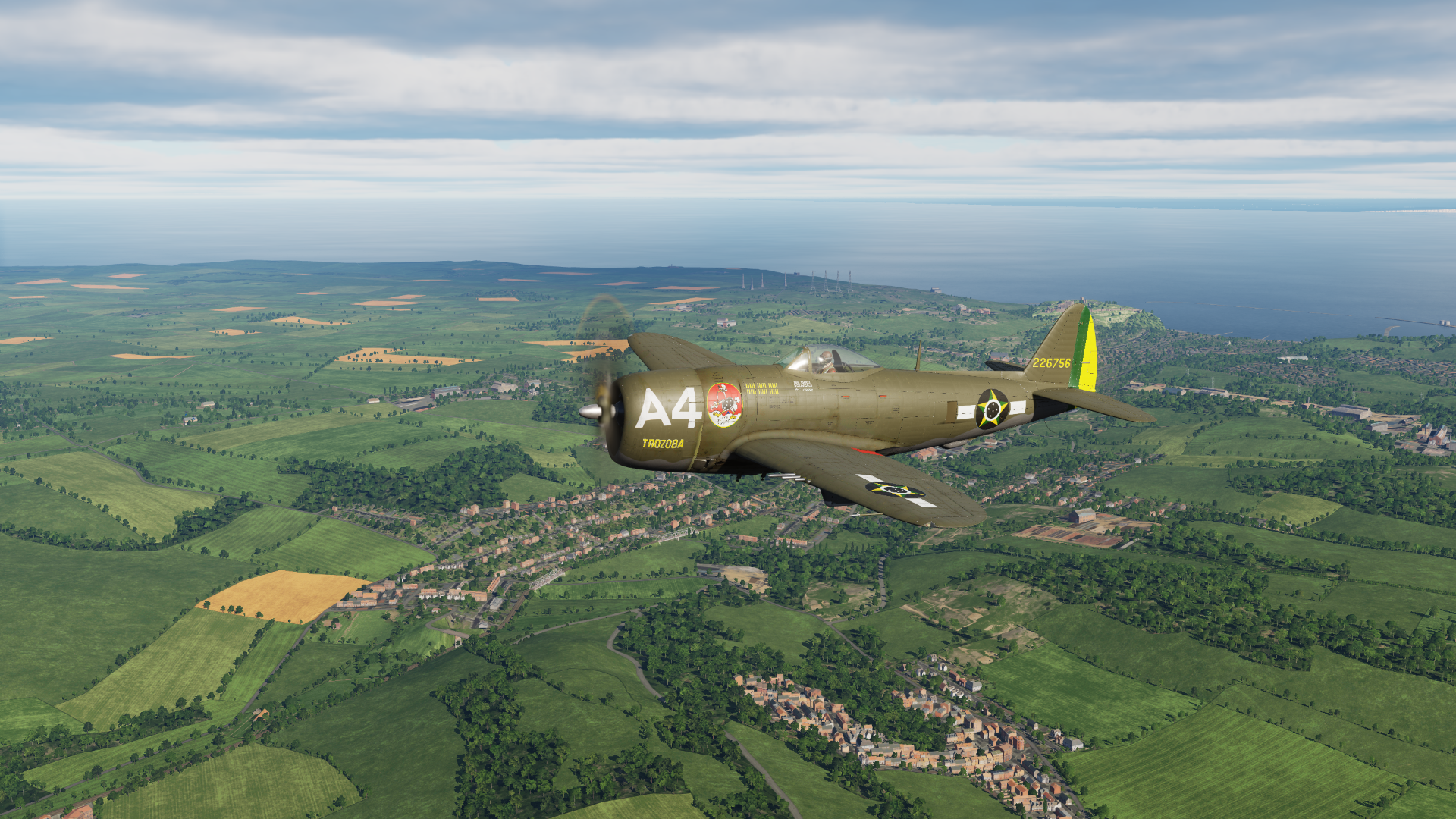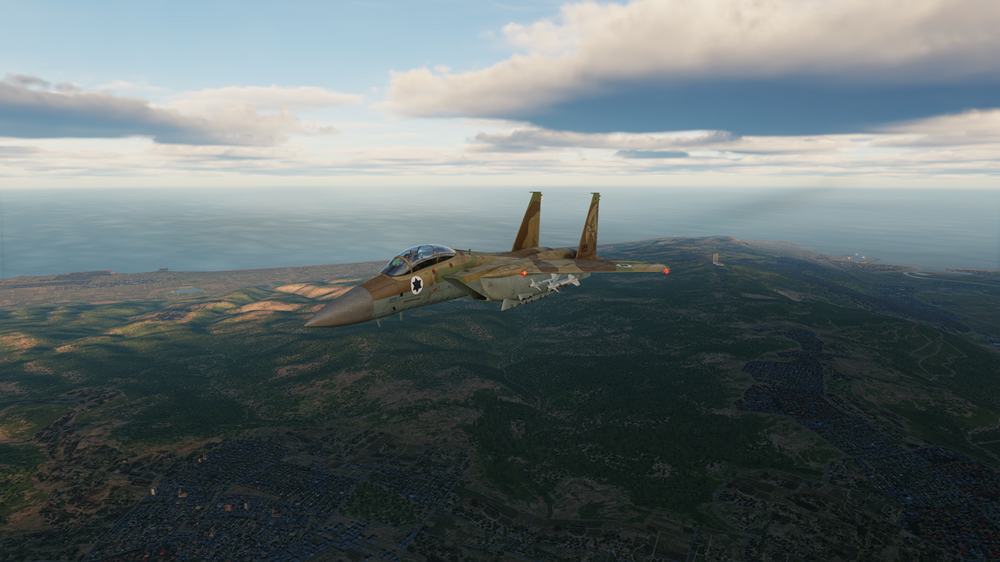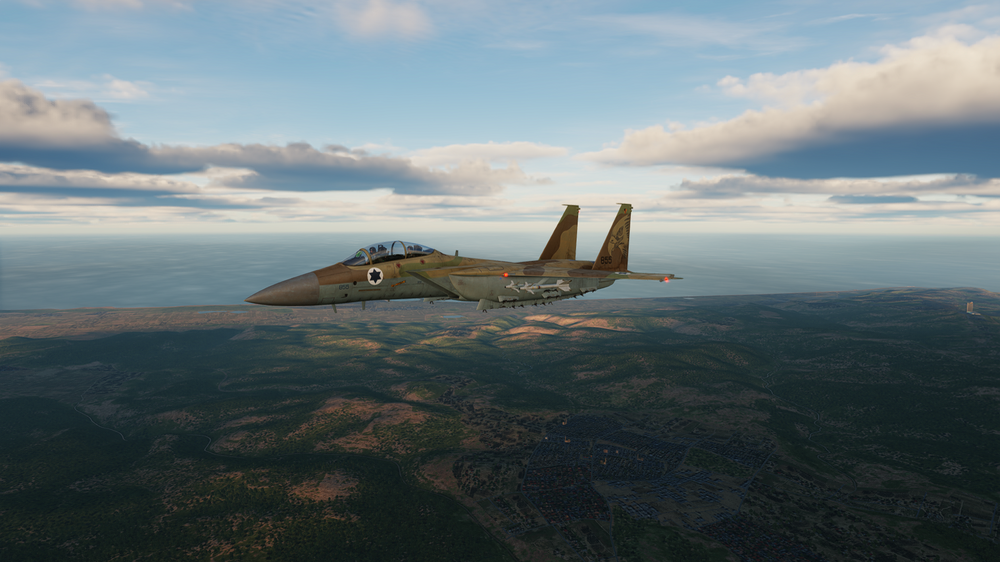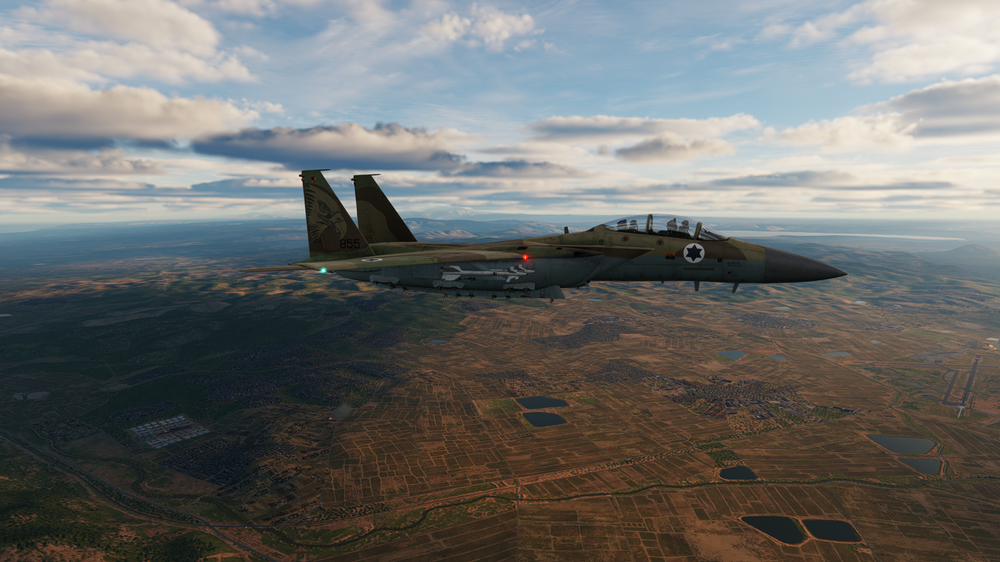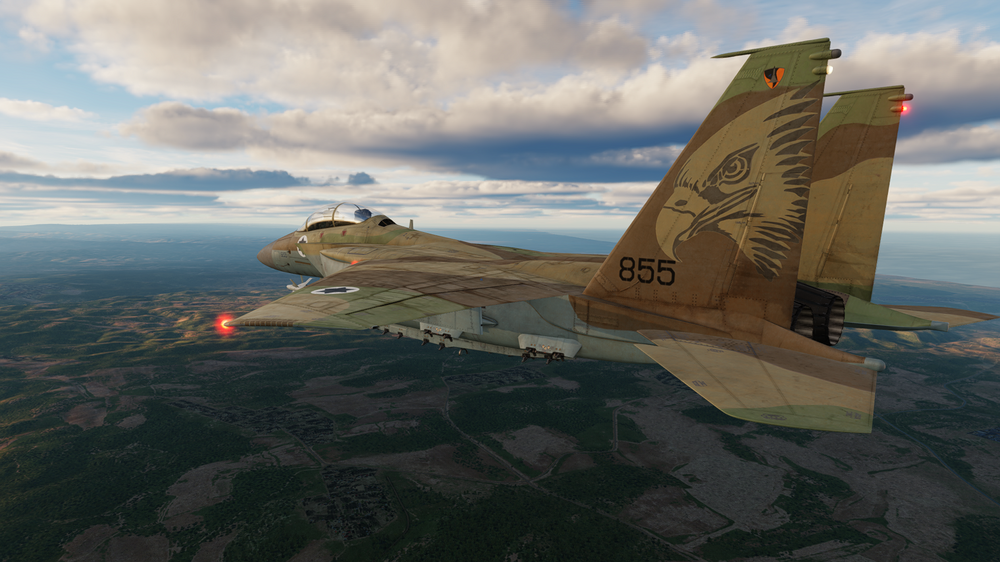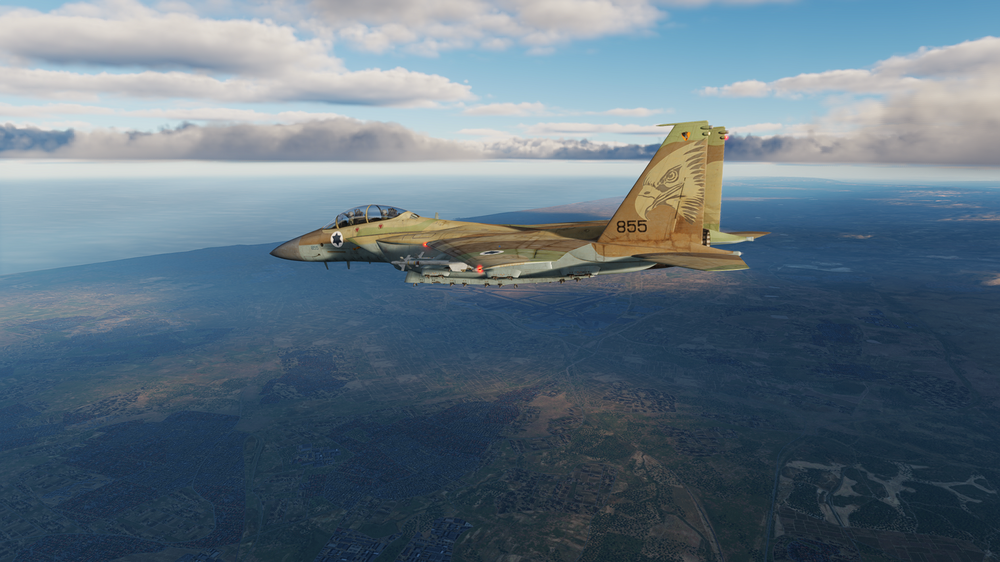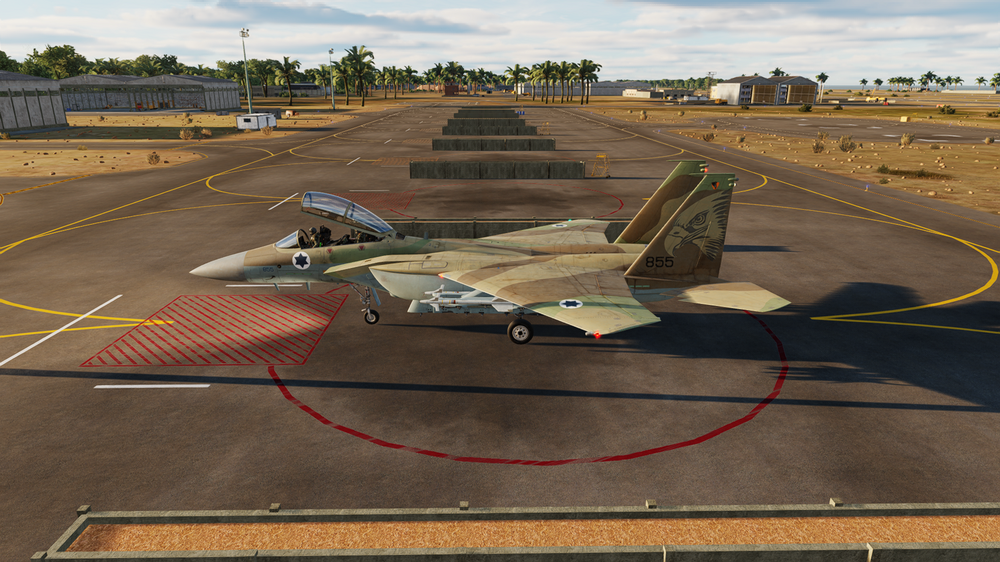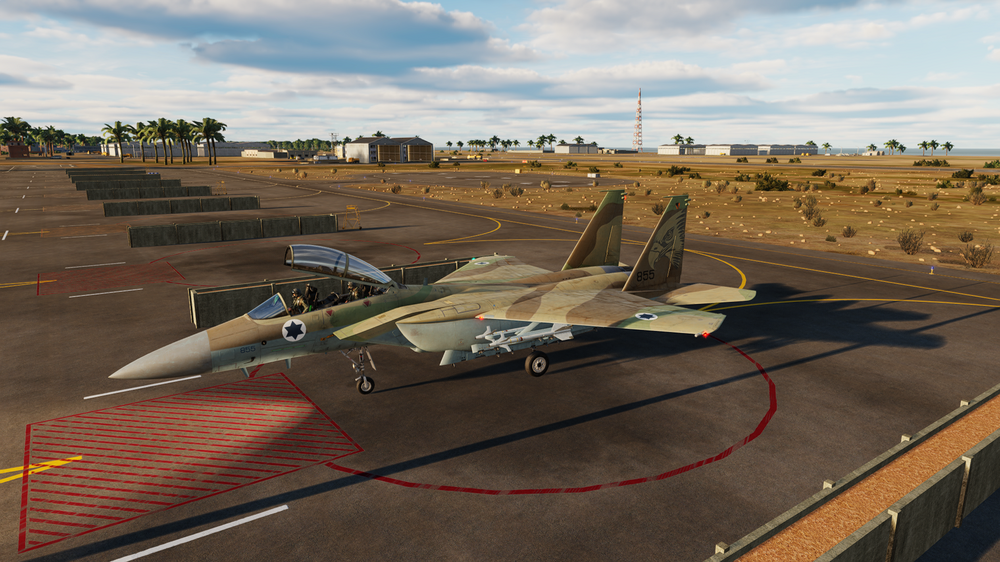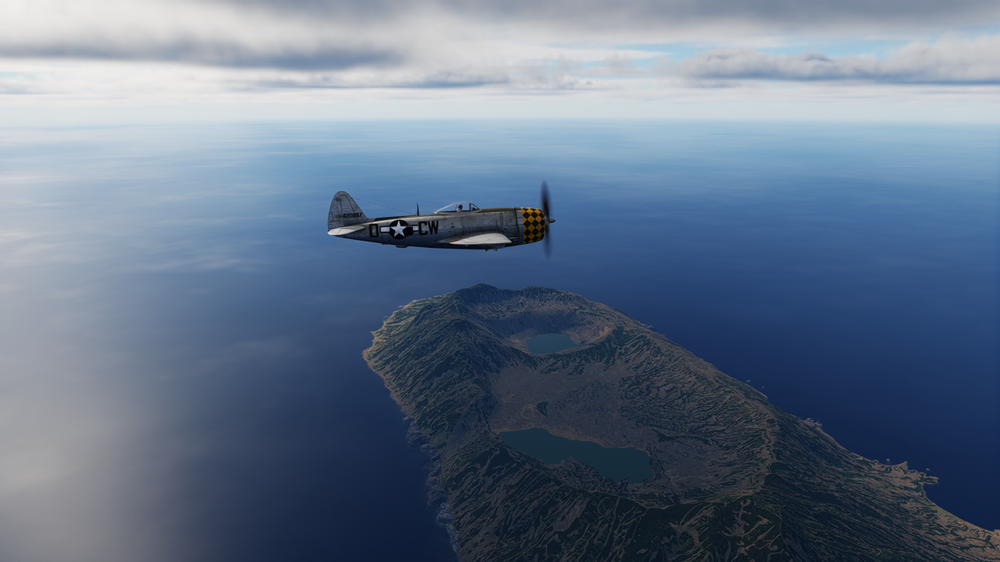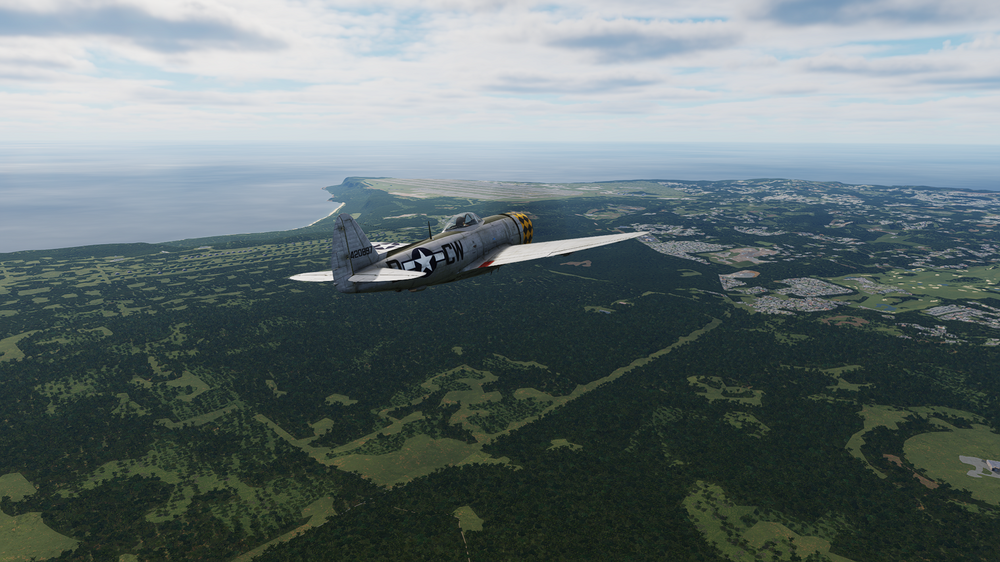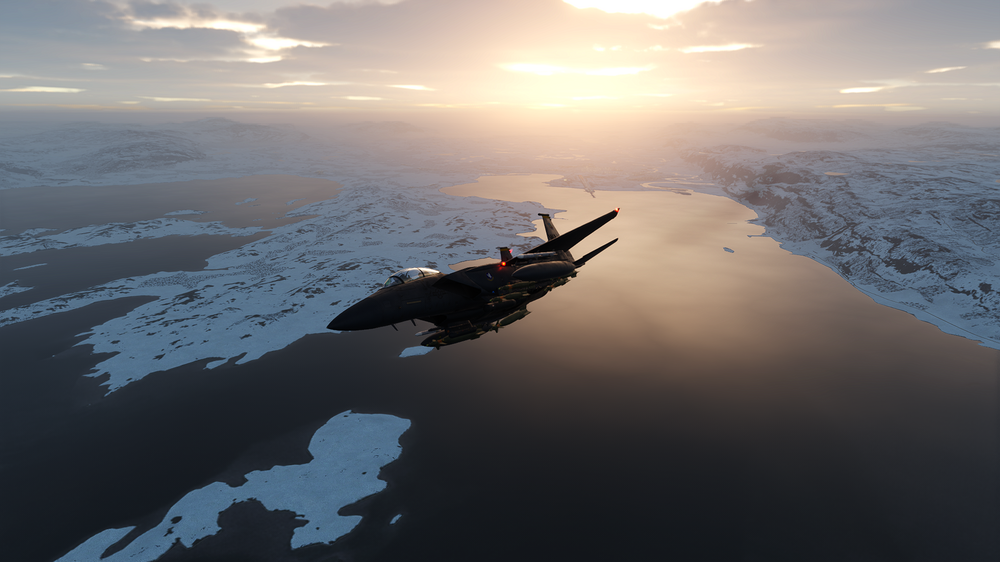-
Posts
258 -
Joined
-
Last visited
Content Type
Profiles
Forums
Events
Everything posted by SloppyDog
-
Hello all! In the learning curve of properly using the F-4 I am at the stage of exploring the various bombing modes. I know it is a 60's and 70's aircraft with its quirks and limitations and that's why I have some questions regarding the bombing modes. Maybe it is a skill issue thing or some modes are not fully developed yet. So, here it goes: 1) Dive Toss and Target Find: Dive Toss works perfectly, only needing lots of training to get it right. Even CBUs 1 and 2 can be used with satisfactory results. Target Find works fine as well, however, using the Pave Spike by oneself can be challenging. It really shows how this type of bombing in the F-4 is a two person job. 2) Offset: an interesting way of using the INS and the radar to find the target. Visual IP mode can be more precise than Radar IP mode. This last one is very imprecise, if you don't mark the exactly right spot in the radar the firing solution will be off, way off, sometimes 1.5 nm off target. It is very hard to try to find your smudge among other smudges in the radar while trying to maintain the right speed. Question #1: Is speed a prime requirement under this mode? Or the INS system knows where you are independently of the time you take to get to the target? Question #2: The bearing inserted in the bombing computer (BC) is the magnetic heading or the true heading? Bug (maybe); When in Visual IP mode, once pressing the Freeze buttons, the Freeze light on the button does not come on. 3) Level Release: Lots of fun. A kind of "welcome back to WWII" mode. Just calculate time of flight using BC in Direct mode, subtract that from time to target and here you go. Although it needs a very good heading, altitude and speed control. 4) 4.1) Laydown modes: Laydown works fine, although in my experience going a little bit higher AGL helps to see the target better. Question #3: Is speed a prime requirement for 'L' mode as well? I saw in other post that it is not critical, since the INS will know where you are and where to release the bombs. 4.2) Dive Laydown: I'm having great difficulty using this mode. I tried to follow the procedure as laid down in the manual. But the bombs are dropped as soon as I press the pickle button. I've tried high angle, low angle, almost level... nothing changes. Don't know what I'm doing wrong. Question #4: Is DL mode fully implemented? 5) Loft: works fine, but one must keep speed and altitude before the pull. Toss modes I'm still studying them, don't know if they are fully implemented.
-

Mission Editor questions involving the Kiowa Radios.
SloppyDog replied to JohnMclane's topic in DCS: OH-58 Kiowa
Yes, it is available for aircraft. Although, the files locations and parameters may vary from one to another. But the logic is the same. For the 1-1 I believe it is a string. To find the format types of the values, and the functions of cockpits arguments, you can refer to page 165 onwards of the DCS User Manual. There is a treasure trove of information in that and most people don't know nothing about it. -

AGM-45 Shrike Quick Guide by Klarsnow - updated June 5th 2024
SloppyDog replied to HB_Painter's topic in DCS: F-4E Phantom
This may help. However I use Loft mode missiles with Loft mode. Also, look for WRCS mode in the manual: https://f4.manuals.heatblur.se/stores/air_to_ground/missiles/shrike.html -
Can you attach the mission file so we can take a look?
-

AGM-45 Shrike Quick Guide by Klarsnow - updated June 5th 2024
SloppyDog replied to HB_Painter's topic in DCS: F-4E Phantom
I found the exactly same problem. I tried with the bomb computer and no joy. I tried manually inputting the data (release Low Angle; pull-up time; release time) in the WSO station, and no joy. I believe that the computer didn't accept my inputs, since I was going by trial and error. I really don't know how to manually calculate the latter two parameters. Anyway, what I'm doing with this mode is to help me engage pre-planned targets. I created this SAM site with an SA-2 and an SA-3 and assorted AAA protecting an airport. The SA-3 is easily defeated with WRGS in loft mode. The problem is the SA-2, with its long range. The best way to defeat this situation was to use LABS mode, setup an IP and the TGT in the Mission Editor. I get very low, at around 500-1000 feet, pass the IP at 20nm from the target, do not push the pickle, otherwise as stated the missiles will be immediately fired. Jester will automatically change to the next waypoint, the TGT, and will start to call out the distance. Once at 16-15 nm, I pop up nose up 30 degrees, fire the missiles then go mid altitude to provide a target. Usually the Shrikes track the target. Closer, they will overshoot the target. This way I've been able to use LABS mode to loft missiles, with an indication of distance and not being dependent of the WRGS system. It is the only way LABS mode has been working for Shrikes. Not even close to what is done with bombs or to what is written in the manual. -
I find the F-4 the most difficult jet to land. But watching some videos, I learned that throttle control does it. If the nose is too high, bump the throttle a little. Too low, take out the throttle a little. Not much trimming. If I try to get on speed with trimming only, I usually end in a bad spot. Also, getting on speed only at final. Before that, 200+ knots. then take out the throttle, slight fast, controlling throttle all the way to the runway. I didn't know abou the pitch down and throttle bump just to appease Jester. I'll definitively try that.
-
Well, if you don't know yet, it is something that you must have in mind when seeing modules announcements: the average time it takes a module from the announcement to release is around 3 to 5 years. And if it is released earlier, it will be in a very alpha state, like the Chinook was. And usually at release, the module will lack subsystems and a complete damage model. The thing I've learned by playing DCS in the last 15 years is that you just don't get into the hype after an announcement. You forget about it and meanwhile you enjoy what you can while you can. And when and if it is released, you enjoy the new toy. In the end, DCS release dates are like Darth Vader's line to Lando Calrissian: "I'm altering the deal, pray I don't alter it any further".
-
1) Do you get a 'chocks in place' confirmation message from the crew chief? You got to ask in the intercom radio. The chocks should appear after receiving confirmation. 2) Sorry, cannot help with this one. Never seen it. 3) Never had seen this before. Does the helo lifts off or only appears to lift off? I would check my commands to see if they are not doubled. Maybe you are pressing some command that is connected to the collective somehow.
-

What is the BOBUP Hold, and where TF is it?
SloppyDog replied to DmitriKozlowsky's topic in DCS: AH-64D
Its a symbology that allows the pilot or the CP/G to "drop" a virtual box in the 3D space. It serves as a reference to the pilot. Examples: when hovering, it allows the pilot to see how much the helicopter is drifting from a set position. Or when in movement, it allows the pilot to see how much he is far from a reference. It is similar to a markpoint in a aircraft, althoug it does not show in the targeting computer memory. -
Cool man. The NTTR is a great map that could gain a facelift. It is my preferred map of all.
-
You are right. I stand corrected. I wrote from memory. Then I watched Notso's video again and saw that his landing was exactly by the book. I didn't want to change my post after that. I should have, as well I should have watched Notso's video before writing my post. My mistake. Again, my mistake. I assumed that the OP was an experienced Hornet pilot transitioning to the F-15E. My teachings, as you said, are my attempt to help a fellow virtual pilot. But I recon that I didn't express myself in the best way. And what I meant by learn by using the TF-51 as a learning tool was for the OP to learn the principles behind a good landing. For example, I started virtually flying in fast jet games, including the mighty old Jane's F-15. Only after I went flying Cessnas in FSX that I properly learned how to land a virtual aircraft. Real life pilots go from the T-6A Texan II, then transition to the T-38, then transition to the F-15E. They start learning with a prop (although a turboprop) airplane, then transition to faster and heavier jets. That's way I don't see a problem if anyone starts learning and training with the TF-51. Heck, the Yak-52 would be an even better aircraft to start learning. Because even if particular procedures change, the same principles apply: learning how to safely and confidently fly at slow speed, how to manage throttle and stick inputs to control speed and rate of descent, how to measure the point of landing, etc. All these principles are applied from a Cessna to a 747. Anyway, that's what I tried to convey. Thank you for pointing my mistakes out and I'll try to be more clear in the future.
-
Watch this video, from Notso, a current Mudhen WSO, which is a Razbam SME: His procedure differs a little bit from the manual, and I find the way he does it easier. He does not worry too much abou AoA before getting to the final. Then it is: open the speed brake as soon as you cross the runway threshold, nose up (watermark) at 10 degress, after touchdown, aero brake with nose up at 12-13 degress. You definitively do not land an F-15E, or any other Air Force jet, as the F-18. The Mudhen is a beast, but you need to take a lot of care when bringing her down. Do you want to challenge yourself and learn how to land any USAF fighter? Try learning how to land the TF-51. It is a great learning tool.
-
-
LOL. It is indeed a challenging mission to take off and land. You need to use half-flaps at take off and have a good control of your speed at landing. No more than 120 knots. Also, taking the bird to a spin before coming to land, i.e., landing light, dos help a lot.
- 1 reply
-
- 1
-

-

CBU-99 with FMU-140 is useless - falls very short in CCIP and CCRP
SloppyDog replied to AndrewDCS2005's topic in Weapon Bugs
I believe he means that the settings in the Store Management Program must be the same as set in the Mission Editor. Of course, it can be challenging since one does not always know what the mission creator set for the payload and fuze settings. Anyway, I've tested the FMU-140 fuze at different settings and altitudes and almost every time the bombs fall short. The best results I has was at 5,000 feet with a opening set at 1,500-1,800 feet. Attached are tracks showing different attack profiles, at different altitudes and different bomb settings. F-18 - CBU 99 - FMU 140 - CCRP - Effective.trk F-18 - CBU 99 - FMU 140 - CCRP - Fall Short 02.trk F-18 - CBU 99 - FMU 140 - CCRP - Fall Short.trk -
I deleted my last post. Turn out that I wasn't using the latest DCS version. My bad. Anyway, I've tested the CBU-99 again. With Mk 339 they are very effective. With FMU-140...well, they are somewhat effective. The fuze works fine, they open the bomb at the set altitude. The thing is, that is bothering other users as seen in other threads is the fact that they do fall short. By a lot. The best results I got was at 5,000 fett AGL with a opening height of about 1,500 - 1,800 feet. The tracks files attached show different attack profiles at different altitudes, with similar results. F-18 - CBU 99 - FMU 140 - CCRP - Fall Short 02.trk F-18 - CBU 99 - FMU 140 - CCRP - Fall Short.trk
-
I'll have to check it out. Maybe the engine exhaust flame effects are clipping through the floor. If you look at the engine on the outside view, you'll see the engine exhaust with flames. At night, dawn or dusk the effect is much more noticeable. Like I said, the P-51 is an older model. And ED has been improving their old models. They added the exhaust flames effect for all of their Merlin engined aircraft, but haven't updated the cockpit models yet.
-
Yes. A2A's Simulations is a software company that, in my opinion, make the best General Aviation aircraft for FSX, Prepar3D and MSFS. However, for MSFS they only have their civilian Comanche, which is a work of art. The P-51 is only available for FSX and Prepar3d. Tough question. We have to first define what is "realism". I'll break down in five categories: - Graphics: DCS graphics are way better than those of FSX and P3D, of course. In my opinion, if you apply Reshade in DCS, the graphics get even better. - Flight Model: I believe DCS flight model is better than those of the A2A's Mustang. A2A's aircraft all use an external flight model processing, outside of FSX and P3D, and then inject the results in the sim. All of the FSX and P3D aircraft use look-up tables, the A2A aircraft use a dynamic look-up table, that change flight parameters based on weight, aircraft attachments, drag, temperature, air density, etc. The problem is when injecting in FSX or P3D, since the results are injected in a single vector on the aircraft. It results in a better flight model than your average FSX /P3D aircraft, but still the aircraft feel like flying on rails. Landing the A2A aircraft is very easy when comparing to the DCS one. The DCS P-51 modelling has a lot of things going on. DCS, if I'm not mistaken, uses look up tables too, but the results are applied in different vectors all over the aircraft. Surely, someone with more knowledge can correct me if i'm wrong. But the end result of the DCS flight modelling is that it reacts to the inputs you make. If you input too much throttle, too fast, the engine torque/propeller torque will rise, the aircraft will tend to roll to one side, it will get out of trim and will be unbalanced. Also, landing the DCS P-51 can be a daunting task. In the past it was more difficult because the new suspension system was not yet implemented. But even with the new suspension now available, you still have to fly by the numbers, ease your way over the runway, have a good throttle and pitch control. Learning how to land this bird is challenging. - Engine management: A2A takes much care in immersion. And their engine management seems better, since in their P-51 you can get to maximum available power and the radiator opening will auto-regulate. It takes a long time for the engine to overheat. On the other hand, DCS P-51 engine overheats very quickly. It seems like the auto regulator of the radiator does not work. Prior to entering combat or ground attack, you must open the radiator all the way, otherwise the engine will overheat and breakdown. But if you the radiator manually, the engine will cool down very rapidly, getting too cold. It seems this way, at least for me. Again, maybe the A2A's and DCS models are different, with different radiator systems and models, but I find easier to trust the engine in A2A's than in DCS. - Immersion: this is the category where A2A is above and beyond DCS, at least the DCS older modules. The A2A's P-51 feels alive, everything in the cockpit shakes at low RPM, the brakes squeal differently with different applied forces and the sound is more captivating. When starting the engine, you can feel, by the sounds and shakes in the cockpit, the engine not wanting to move away from its inertia, fighting the system, then sputtering to life, with fire and smoke effects. It is amazing every single time. And if you don't follow the procedures, the engine will flood and not start. And you have to wait for the vapors to leave the engine and then you can try again. And is a procedure for flooded engines that you must follow. It is great. Also, the A2A's aircraft simulate wear and tear. If you abused the engine or the brakes in the last flight, you will have problems in your next flight. This detail makes you really take care of your bird. However, the DCS one, although with some shaking effects, feels sterile. Every time you try to start the engine it will start. There is no challenge or need to strictly follow the procedures. That is in my opinion, at least. The first DCS modules that I noticed them feeling more alive were the Apache and the Hind, where things shakes, rattle, the aircraft complains if you input too much movements on the controls. - Combat: DCS is made for combat. FX and the P3D ones are only cosmetics, you can not fire the guns or drop bombs. Anyway, these were my 2 cents. I hope I helped you learn more about the two of them. I like the DCS P-51, and its training version, the TF-51, because they are challenging to fly. But What I really love is the P-47, because being an newer module, has more details that make it feel more alive.
-
1) Yes, it is. If you fly the A2A's Simulations P-51, you will see that the battery on the P-51 is very limited, as it is in real life. DCS P-51 does not simulate that. 2) It is required to keep the mixture on Idle/Cutoff in order to not flood the engine. If you inject too much fuel in the engine, it won't start. As you already inject fuel prior to start-up by priming the engine, it already has enough fuel to start. Once started, the amount of fuel injected will be consumed, then you can/must change the mixture to run. After that, the mixture is mechanically auto-regulated and the engine will work on its own.
-
This is correct. I'm having a lot of success releasing Mk20s at low level. Be it on the F-15E, the F/A-18C and even in the F-4 (in laydown mode), they work very well at their default settings. Below I present a spreadsheet showing the predicted height over target of the ARMED bomblets over the target. The detail is that we must consider not only the time for the canister open after release, but also the time it takes the bomblets to be armed. Again, I'm having a lot of success with the immediate release mode at default settings, which are Time of Function (meaning, time for the canister to open) of 1.28 seconds, plus the CBU-99 time delay of 1.1 seconds. Trucks, APCs are easily destroyed, moreover if you send multiple CBUs over the area (pairs, trios or in fours). Tanks require a direct hit, but in this low level, immediate release, they are either destroyed or damaged. Check the attached track for a test using the F-15E releasing CBUs in trios. This is where things get complicated and interesting. Mk20 only allow for the use of the Mk 339 Mod 1 time fuze. CBU-99s on the other hand allow for the use of the time fuze but also the use of the radar fuze, proximity fuze, or variable time (VT) fuze that is the FMU-140. In theory, the use of the FMU-140 allows for the opening of the CBU-99 at a certain programmed height, independent of time. So, the difference is: with a Mark 20 with the default fuzing of PRI at 1.2 seconds, it does not matter if the aircraft is at 500 feet or at 10,000 feet. At 1.2 seconds after pickle, the canister will open and will spread the bomblets over the area. At 500 ft, they will be more concentrated and hit the targets. At 10,000 feet they will spread out and will be all over the place, falling long and being drifted by the wind. However, with a CBU-99 set to open at a height of 300 feet, if the aircraft drops it at 500 feet, the canister will open at 300 feet and the bomblets will be very concentrated in the area. The same occurs for an aircraft at 10,000 feet: releasing from this altitude, the canister will open at 300 feet AGL and the bomblets will be concentrated at the area. Success, right? No. Unfortunately not. A very important and often overlooked thing is the ARM Delay setting. The ARM Delay exists to ensure that the releasing aircraft is not damaged by its own bombs or bomblets after dropping the canisters. Let's refer to the spreadsheet below: 1) At line 4 of the spreadsheet, we have a CBU-99 with the Mk 339 Mod 1 time fuze. 2) In column A we have the aircraft altitude above the ground (AGL). 3) Next to it we have the Primary (PRI) time fuzing setting of 1.28 seconds. 4) At column D we have that the canister will open 26.36 feet below the aircraft. 5) At column F it shown that the canister is opened at 473.64 feet over the target. That would be a great spread, right? Not exactly, because we must take in consideration the ARM delay setting. For the Mk 339 fuze, the arm delay is fixed at 1.1 seconds. 6) So, moving to the right in the spreadsheet, we see in column I that the time for the bomblets to be released AND armed is of 2.39 seconds after release. It corresponds to a height 91.89 feet below the aircraft after launch, as seen in column K. 7) What this means is that the bomblets will be armed over the target at a height of 408.11 feet AGL, as seen in column M. The end result is that it is good enough to destroy targets, but we must have in mind that the bomblets were not ready to explode at 500 feet, but roughly at 100 feet below, due to the Time of Function (time to open the canisters) and Arm Delay (time to arm the bomblets after the canister was opened. If you follow the same steps, but for the OPT setting of 4 seconds of Time Of Function, we can see on column N of the line 4 that the bomblets will be armed only at 79.93 feet. At this height many may hit the target, but not destroy it. A worst case is on line 5, using an OPT setting of 8 seconds. In column N, we get a height for armed bomblets of -835.09 feet. It means that the bomblets won't have any time to arm before hitting the target, if released from 500 feet AGL. The other lines show various results for different altitudes and fuze settings. Let's see line 11, dropping a CBU-99 at 10,000 feet, with a PRI fuze setting of 23 seconds and an OPT fuze setting of 24 seconds. In column M we can check that for the PRI setting, we have bomblets armed at 648.75 feet, which will give a good spread over target. However, if we use the OPT setting, only 1 second later, the result in the N column is of -143.05 feet, meaning that if the canister is opened only 01 second later, there won't be enough time for the bomblets to arm. All you will get is a dud over target. This happens due to the acceleration of gravity, that makes speed grows linearly, and causes displacement (distance) to grow quadraticaly over time. It means that for every second passed, the time required to cover 100 feet, for example, will diminish dramatically. Moving on to the FMU-140, at line 17 we see that for a canister dropped from 500 feet, with a time function of 300 feet over target. Considering an ARM time delay of 1.2 seconds, we get that, at column L, a height of armed bomblets over target of only 140 feet. Again, in my opinion, not ideal. If we look at line 19, dropping a CBU-99 from 1,000 feet with a 700 feet height of function, we get that the height where the bomblets will be armed over the target is 510.11 feet AGL. Which, for me, is a good result. So, let's get back to our example of dropping a CBU-99 from 10,000 feet with a height of function at 300 feet. The results for this example can be seen on line 28. In the column L we see that the height where the bomblets will be armed of the target is of -671.22 feet. Again, you would get a dud due to not giving enough time for the bomblets to arm. So, for releasing a CBU-99 from 10,000 feet, the best height of functions should be 1,500 and 1,800 feet as seen on lines 31 and 32. These settings will give the height where the bomblets will be armed in column L, at 589.36 and 905.16 feet AGL respectively. Of course, there are other factors to take in consideration, as spread of the bomblets when the opening over the area, type of targets and enemy air defenses. All in all, the best way to use CBUs is to either fast and low or in a dive, releasing from a low altitude as well. Anyway, I hope I helped to clarify your questions. And I sincerely apologize if I made it more complicated. Notes about the spreadsheet: it is in Brazil's notation, so the decimals and thousands are inverted. In the U.S. for instance, decimals are expressed with a dot and thousands with a comma. For us, it is inverted. Also, I did not consider drag or other factors, only plain old high school physics. Attached files: Excel spreadsheet - CBU 99 Height of Function.xlxs Image - CBU Height of Function.png TacView File - Tacview-DCS-F-15E - CBU-99 Test.zip.acmi - Shows the success of using CBU-99 at low altitude. TacView File - Tacview-DCS-F-18 - CBU-99 Test.zip.acmi - Shows a dud with the improper use of the wrong setting for the CBU-99. Height setting at 300 feet. Track file - F-15E - CBU 99 - 1500 ft.trk - Track file containing two successfull atacks with the F-15E at low level. Mission File - CBU-99 Test.miz - Mission file used to make the tests. CBU-99 Height of Function.xlsx F-15E - CBU 99 - 1500 ft.trk CBU-99 Test.miz Tacview-DCS-F-18 - CBU-99 Test.zip.acmi Tacview-DCS-F-15E - CBU-99 Test.zip.acmi
-
-
Something that the old FSX did beautifully. Not perfect, but for the most part did it well. In 2006. So, yeah, DCS needs this to add to the immersion. It is sorely missed in the sim.
-
The secret that the ATC system in DCS is borked. Outdated and obsolete. It works...ok-ish for start-ups and after start-up to taxi clearance. It works when announcing the landing and when it asks you to contact tower. In order to "contact tower", use the same radio, the same frequency and a new option will appear on the menu. No need to switch frequencies as it would in real life. And it does not work when requesting take-off clearance. You need to get past the hold line and...well, enter the runway, just a little. Then contact ATC and it will answers with clearance. ] But, above all, do not expect realistic or logical behavior from the DCS ATC. Your experience may vary, by a lot. Even MSFS ATC system is way better. Not to mention the BMS system, which is very smart. ED said they are working on a new system, but they stated that it is still in development and years away to be released in the sim. DCS ATS and ground units comms: it is what it is and will be like this for a long time.
-
-
Buy it, if you love it! Meaning: Do you know what is it for? Do you know it was purpose built to do one thing and one thing only, but very well done? Do you know it is a indirect descendant of the F-111? Albeit slower, but much more A-A capable? Anyways, if you know for what it was built to, what is its mission and what you can do with it, you will be a very happy camper. The big mistake people made when buying it was to expect it to be a great dogfighter. A lot of people were clamoring for the removal of the CFTs in order to make it more maneuverable. But, IMO, they were wrong, and didn't understand what the Mudhen is and what it was made to do. I know it has been used to patrol No-Fly Zones in Iraq and in the Baltic States to keep the Russian at bay, using solely Air-to-Air loadouts. It is a great BVR fighter, the most powerful radar in the game. But what is great about it is to fly low and fast, this is where it likes to be. You can go 500 nm at 500 knots at 500 feet from the ground, and only then start worrying about your fuel state. That loaded with 4 GBU-12's and 2 GBU-10s and two bags. It is an amazing bird. Regarding the lack of modern gizmos like the JHCMS and Link-16...well, for me it doesn't make any difference, since I play 99% of time in A-G mode. But a having newer, more modern TPOD wouldn't hurt. The state it is now in game is playable, it is a lot of fun. Has some unattended bugs, but nothing that makes the module completely broken. In the state that it is now, you can simulate Late Cold War scenarios, like the Gulf War. Or the Global War on Terror, with no contested airspace. Anyway, if you love it, buy it. If you know that it is mostly a Strike platform, that can perform other roles, but was purpose built to deliver bombs deep inside enemy territory following a Cold War doctrine, you won't be disappointed. Just don't expect it to out turn an F-16.

